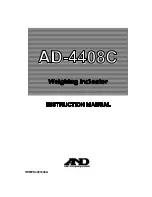
8
9
TEMPERATURE MEASUREMENTS
TEMPERATURE MEASUREMENTS
TEMPERATURE MEASUREMENTS
TEMPERATURE MEASUREMENTS
TEMPERATURE MEASUREMENTS
Connect the
HI 7662
temperature probe to the TEMP
socket and turn the instrument on.
Immerse the temperature probe into the sample and
allow the reading on the secondary LCD to stabilize.
MEMORY FUNCTION
MEMORY FUNCTION
MEMORY FUNCTION
MEMORY FUNCTION
MEMORY FUNCTION
Press and hold down
MEM
. The last reading will appear on the LCD
along with “MEM” tag until
MEM
is released.
Press
MR
and the previously memorized reading will be displayed
with “MEM” tag on the LCD.
C
If measurements are taken successively in different samples, it is
recommended to rinse the electrode thoroughly with deionized water
or tap water and then with some of the next sample in order to
prevent cross-contamination.
The pH reading is affected by temperature. In order to measure the
pH accurately, the temperature effect must be compensated for.
To use the
Automatic Temperature Compensation
feature, connect
and submerge the
HI 7662
temperature probe into the sample as
close as possible to the electrode and wait for a few seconds.
If the temperature of the sample is known,
manual temperature
compensation
can be performed by disconnecting the temperature probe.
The display will then show the default temperature
of 25 °C or the last recorded temperature reading
with the “°C” tag blinking. The temperature can now
be adjusted with the
ARROW
keys (from -9.9 °C to
120.0 °C).
ORP MEASUREMENTS (H
ORP MEASUREMENTS (H
ORP MEASUREMENTS (H
ORP MEASUREMENTS (H
ORP MEASUREMENTS (HIIIII 2
2
2
2
22222211
11
11
11
11 only
only
only
only
only)))))
An optional ORP electrode must be used to perform ORP measurements
(see Accessories).
Oxidation-reduction potential (REDOX) measurements provide the
quantification of the oxidizing or reducing power of the tested sample.
To correctly perform a redox measurement, the surface
of the ORP electrode must be clean and smooth.
• Press
RANGE
to enter mV range.
• Submerge the tip of the ORP electrode 4 cm
(1½") into the sample to be tested and allow a
few seconds for the reading to stabilize.
• The instrument displays the mV reading on the primary LCD and
the temperature on the secondary LCD.
• If the reading is out of range, “----” will be displayed on the
LCD.
mV
C

































